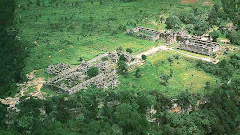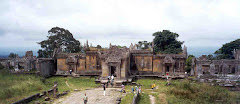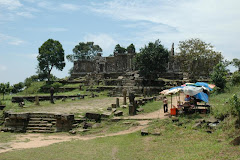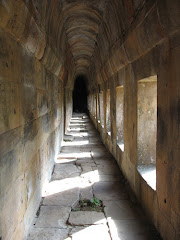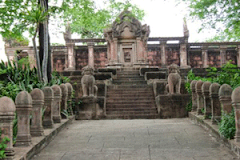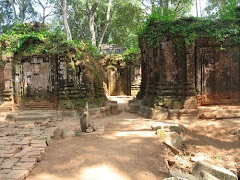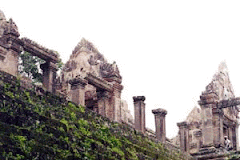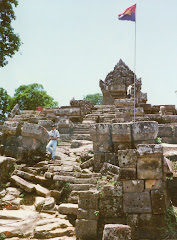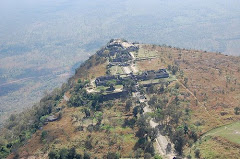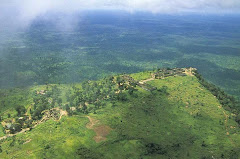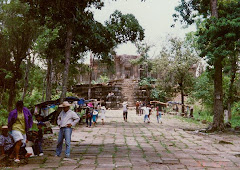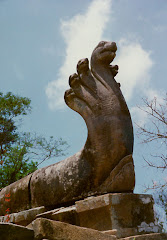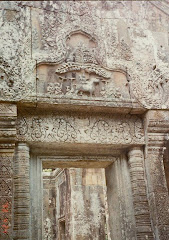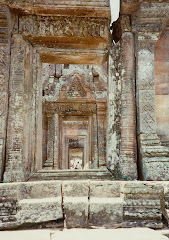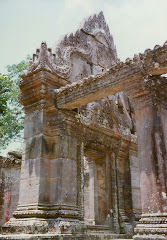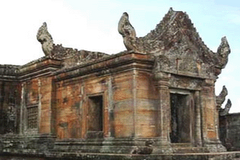Khmer Glossary
The following is a list of words which reappear often in descriptions of the history of Angkor and its temples in Khmer.
Acarya: Spiritual guide, teacher, instructor of religious mysteries.
Aditya: Rising sun (suffix) .
Airavata: Multi-headed elephant; India's vehicle.
Amitabha: The "Father" Buddha (Mahayana Buddhism). In Khmer art a seated Buddha meditating; depicted on the headdress of a bodhisattva.
Amrita: The drink of immortality that was created by the Churning of the Ocean of Milk.
Ananta: see Vasuki.
Anastylosis: Method of restoring a monument; can imply dismantling and rebuilding the structure using the original methods and materials.
Angkor: From the Sanskrit nagara (holy city). In Thai is nakhon and in Cham nagar. Ancient capital in Cambodia: was the main centre of the Khmer Empire from AD 802 to 1432.
Angkor Thom: The 'great' city. Built by Jayavarman VII in the late 12th century . It is positioned north of Angkor Wat (the temple of the Bayon at its centre). At its peak this was the largest city in the world and the centre of a great empire.
Apsara: Celestial nymphs or dancers represented in the shape of flying figures; at Angkor, the stylisation is extreme and the apsaras are often represented in groups with finery and jewels. They are the "divine symbol of happiness" (Maurice Glaize).
Ashrama: A retreat for ascetics or hermits who devote themselves to preparing for the next life.
Asura: Demon, enemy of the gods, with god-like power that represents the forces of evil.
Avalokitesvara or Lokesvara: "Compassionate bodhisattva", linked to the idea of Providence; often represented with four arms and bears Amitabha on his chignon; attributes: lotus, rosary, bottle and book.
Avatar: Literally "descent" in Sanskrit, the incarnation of a god in a human or animal being. The 7th and 8th avatars of Vishnu, Rama and Krishna, are the most famous cf. the Ramayana and Mahabarata.
Balarama: The elder twin brother of Krishna; Vishnu's eighth avatara .
Baluster: Short posts or pillars that support a rail and forms a balustrade.
Banteay: Fortress or citadel. It has been applied to temples because of their encircling walls.
Baray: Rectangular compensating reservoir; more than a pond, it is a dyke filled by rain and diversion of rivers. Its function is to ensure irrigation of the neighbouring fields and to supply the sanctuaries' moats. The baray is at the basis of the Angkorian hydraulic system; progressive silting up may have contributed to the weakening of the successive Angkorian kingdoms. It also bears a sacred and symbolic function, as well as an economic one, witnessed by temples erected at their centres (West and East Mebon).
Bas-relief: Sculpture in low relief. The figures project less than half the true proportions from the background.
Bodhisattva: A being poised to become a Buddha, but who renounces its own salvation in order to help humankind.
Bodhi tree : Enlightenment tree: Buddha became enlightened while meditating under it.
Boeng: lake.
Brahma: One of the principal gods of the Brahmanic trinity, the "creator"; generally represented with four faces and four arms, mounted on the Hamsa or sacred goose; his attributes include: disc, ladle, book, rosary, vase, flywhisk and sceptre.
Brahmin: The priestly class in Vedism and Hinduism.
Brahmanism: The early religion of India that emanated from Vedism.
Buddha: Compassionate being who has attained spiritual enlightenment. Gautama Siddhartha was the first Buddha, he lived in the sixth century BC.
Buddhism: The Buddhist religion that adheres to the basic principles of non-violence, compassion, and generous works.
Cambodia: South-east Asia country, bounded by Laos, Thailand, Vietnam and the Gulf of Thailand.
Causeway: Raised road.
Chakra: The "wheel" of the Buddha symbol of immortality and power; solar-disc; disc-like weapon of Vishnu
Chakravartin: Universal sovereign; a title for the supreme king or universal overlord. From the Sankrit term for one who turns the wheel of the law.
Cham: Ancient inhabitant of Champa, a Hindu kingdom situated along the coast of former Annam.
Champa: An ancient Indianised state and rival of the Khmer Empire. It was situated in an area corresponding approximately to present-day south and central Vietnam. It existed from the second century to the fifteenth century. the Chams A people speaking an Austronesian language who occupied southern coastal Vietnam and were often enganged in war with the Khmer.
Chenla: Former Chinese name for former kingdoms of 'Land Chenla' and 'Water Chenla' that occupied areas that were later incorporated into the Khmer Empire.
Churning of the Sea of Milk: The devas (gods) and the asuras (demons) hold a huge naga (the naga King Vasuki) twisted around the Mandala mountain in order to accomplish the churning of the primordial ocean, thus extracting the Liquor of Immortality (Amrita) which each group covets. A famous bas-relief at Angkor Vat illustrates this episode extracted from Hindu mythology.
Deva: (feminine = devi) (devata in Sanskrit); deity that is often a guardian. Heavenly or divine.
Devaraja: Cult of the 'god-king', created for Jayavarman II on Phnom Kulen in 802 by the Royal Brahmins; based on the tenet that the king was an emanation of a god, usually represented in Khmer art by a linga symbolizing the spiritual and royal essence of the king; the reigning monach became identified with the Hindu god Shiva.
Devata: A deity, celestial being; gods, male and female, of Buddhism and Brahmanism; a recurrent motif on Khmer architecture.
Dhuli jen: Literally, dust of the feet. Dhuli jen vrah kamraten an is the highest title a king could bestow.
Dvarapala: Squatting or standing temple, door or gate guardian of Brahmanic or Buddhist temples usually armed with spear, mace or club, whose presence ensures protection from evil influences.
Dvaravati: Mon kingdom in Thailand from approximately the sixth or seventh century to the eleventh century.
Fan : Title for overlords or kings of Funan in Chinese histories. Equivalent of pon in Khmer.
Funan: Chinese name for an ancient Indianised kingdom, probably the predecessor to Angkor; located in the lower Mekong basin; although it existed in the first century AD, its zenith was the fifth century; in the seventh century it was eclipsed by the state of Zhenla.
Ganesha: God associated with wisdom and knowledge, son of Shiva and Parvati; he is represented with a human body with an elephant head and trunk that often plunges into a bowl (symbolising the quest for knowledge).
Garuda: Divine bird, with a human body, enemy of the nagas, mount of Vishnu. The garuda-naga is a recurrent motif in Khmer sculpture; the garuda is often represented mounted on the naga.
Gopura: Gateway to a temple in south India; entrance pavilion in enclosure walls around a temple. Often found in Khmer architecture.
Guru: Spiritual guide.
Hamsa: Sacred goose; Brahma's mount
Hanuman: In the Ramayana, chief of the army of monkeys.
Harihara: A syncretic divinity combining the attributes of Hari (Vishnu, on the left) and Hara (Shiva, on the right).
Hinayana: "Hinayin", or 'Small Vehicle', Buddhist sect.
Hinayana Buddhism: The 'Small Vehicle'; school of Buddhism, predominant religion in Cambodia in the 15th century; more commonly called Theravada Buddhism.
Hinduism: Religion and social system of the Hindus; popular in Cambodia especially from the first century to the 12th century.
Hotar: Priest .
Indra: Hindu god of war and tempests (from the east).
Isvara: intrinsic q ualities of Shiva (suffix).
Jaya: Sanskrit word for victory (prefix).
Jyan: Weight measure.
Kailasa: Mythical mountain in the Himalayas and the abode of Shiva.
Kala: Creature with bulbous eyes, human or lion's nose, two horns, clawlike hands and a grinning face.
Kalkin: see Vishnu.
Acarya: Spiritual guide, teacher, instructor of religious mysteries.
Aditya: Rising sun (suffix) .
Airavata: Multi-headed elephant; India's vehicle.
Amitabha: The "Father" Buddha (Mahayana Buddhism). In Khmer art a seated Buddha meditating; depicted on the headdress of a bodhisattva.
Amrita: The drink of immortality that was created by the Churning of the Ocean of Milk.
Ananta: see Vasuki.
Anastylosis: Method of restoring a monument; can imply dismantling and rebuilding the structure using the original methods and materials.
Angkor: From the Sanskrit nagara (holy city). In Thai is nakhon and in Cham nagar. Ancient capital in Cambodia: was the main centre of the Khmer Empire from AD 802 to 1432.
Angkor Thom: The 'great' city. Built by Jayavarman VII in the late 12th century . It is positioned north of Angkor Wat (the temple of the Bayon at its centre). At its peak this was the largest city in the world and the centre of a great empire.
Apsara: Celestial nymphs or dancers represented in the shape of flying figures; at Angkor, the stylisation is extreme and the apsaras are often represented in groups with finery and jewels. They are the "divine symbol of happiness" (Maurice Glaize).
Ashrama: A retreat for ascetics or hermits who devote themselves to preparing for the next life.
Asura: Demon, enemy of the gods, with god-like power that represents the forces of evil.
Avalokitesvara or Lokesvara: "Compassionate bodhisattva", linked to the idea of Providence; often represented with four arms and bears Amitabha on his chignon; attributes: lotus, rosary, bottle and book.
Avatar: Literally "descent" in Sanskrit, the incarnation of a god in a human or animal being. The 7th and 8th avatars of Vishnu, Rama and Krishna, are the most famous cf. the Ramayana and Mahabarata.
Balarama: The elder twin brother of Krishna; Vishnu's eighth avatara .
Baluster: Short posts or pillars that support a rail and forms a balustrade.
Banteay: Fortress or citadel. It has been applied to temples because of their encircling walls.
Baray: Rectangular compensating reservoir; more than a pond, it is a dyke filled by rain and diversion of rivers. Its function is to ensure irrigation of the neighbouring fields and to supply the sanctuaries' moats. The baray is at the basis of the Angkorian hydraulic system; progressive silting up may have contributed to the weakening of the successive Angkorian kingdoms. It also bears a sacred and symbolic function, as well as an economic one, witnessed by temples erected at their centres (West and East Mebon).
Bas-relief: Sculpture in low relief. The figures project less than half the true proportions from the background.
Bodhisattva: A being poised to become a Buddha, but who renounces its own salvation in order to help humankind.
Bodhi tree : Enlightenment tree: Buddha became enlightened while meditating under it.
Boeng: lake.
Brahma: One of the principal gods of the Brahmanic trinity, the "creator"; generally represented with four faces and four arms, mounted on the Hamsa or sacred goose; his attributes include: disc, ladle, book, rosary, vase, flywhisk and sceptre.
Brahmin: The priestly class in Vedism and Hinduism.
Brahmanism: The early religion of India that emanated from Vedism.
Buddha: Compassionate being who has attained spiritual enlightenment. Gautama Siddhartha was the first Buddha, he lived in the sixth century BC.
Buddhism: The Buddhist religion that adheres to the basic principles of non-violence, compassion, and generous works.
Cambodia: South-east Asia country, bounded by Laos, Thailand, Vietnam and the Gulf of Thailand.
Causeway: Raised road.
Chakra: The "wheel" of the Buddha symbol of immortality and power; solar-disc; disc-like weapon of Vishnu
Chakravartin: Universal sovereign; a title for the supreme king or universal overlord. From the Sankrit term for one who turns the wheel of the law.
Cham: Ancient inhabitant of Champa, a Hindu kingdom situated along the coast of former Annam.
Champa: An ancient Indianised state and rival of the Khmer Empire. It was situated in an area corresponding approximately to present-day south and central Vietnam. It existed from the second century to the fifteenth century. the Chams A people speaking an Austronesian language who occupied southern coastal Vietnam and were often enganged in war with the Khmer.
Chenla: Former Chinese name for former kingdoms of 'Land Chenla' and 'Water Chenla' that occupied areas that were later incorporated into the Khmer Empire.
Churning of the Sea of Milk: The devas (gods) and the asuras (demons) hold a huge naga (the naga King Vasuki) twisted around the Mandala mountain in order to accomplish the churning of the primordial ocean, thus extracting the Liquor of Immortality (Amrita) which each group covets. A famous bas-relief at Angkor Vat illustrates this episode extracted from Hindu mythology.
Deva: (feminine = devi) (devata in Sanskrit); deity that is often a guardian. Heavenly or divine.
Devaraja: Cult of the 'god-king', created for Jayavarman II on Phnom Kulen in 802 by the Royal Brahmins; based on the tenet that the king was an emanation of a god, usually represented in Khmer art by a linga symbolizing the spiritual and royal essence of the king; the reigning monach became identified with the Hindu god Shiva.
Devata: A deity, celestial being; gods, male and female, of Buddhism and Brahmanism; a recurrent motif on Khmer architecture.
Dhuli jen: Literally, dust of the feet. Dhuli jen vrah kamraten an is the highest title a king could bestow.
Dvarapala: Squatting or standing temple, door or gate guardian of Brahmanic or Buddhist temples usually armed with spear, mace or club, whose presence ensures protection from evil influences.
Dvaravati: Mon kingdom in Thailand from approximately the sixth or seventh century to the eleventh century.
Fan : Title for overlords or kings of Funan in Chinese histories. Equivalent of pon in Khmer.
Funan: Chinese name for an ancient Indianised kingdom, probably the predecessor to Angkor; located in the lower Mekong basin; although it existed in the first century AD, its zenith was the fifth century; in the seventh century it was eclipsed by the state of Zhenla.
Ganesha: God associated with wisdom and knowledge, son of Shiva and Parvati; he is represented with a human body with an elephant head and trunk that often plunges into a bowl (symbolising the quest for knowledge).
Garuda: Divine bird, with a human body, enemy of the nagas, mount of Vishnu. The garuda-naga is a recurrent motif in Khmer sculpture; the garuda is often represented mounted on the naga.
Gopura: Gateway to a temple in south India; entrance pavilion in enclosure walls around a temple. Often found in Khmer architecture.
Guru: Spiritual guide.
Hamsa: Sacred goose; Brahma's mount
Hanuman: In the Ramayana, chief of the army of monkeys.
Harihara: A syncretic divinity combining the attributes of Hari (Vishnu, on the left) and Hara (Shiva, on the right).
Hinayana: "Hinayin", or 'Small Vehicle', Buddhist sect.
Hinayana Buddhism: The 'Small Vehicle'; school of Buddhism, predominant religion in Cambodia in the 15th century; more commonly called Theravada Buddhism.
Hinduism: Religion and social system of the Hindus; popular in Cambodia especially from the first century to the 12th century.
Hotar: Priest .
Indra: Hindu god of war and tempests (from the east).
Isvara: intrinsic q ualities of Shiva (suffix).
Jaya: Sanskrit word for victory (prefix).
Jyan: Weight measure.
Kailasa: Mythical mountain in the Himalayas and the abode of Shiva.
Kala: Creature with bulbous eyes, human or lion's nose, two horns, clawlike hands and a grinning face.
Kalkin: see Vishnu.
Kamratan: High religious title, superior to a kamsten.
Kamsten: Religious title.
Khleang: "Emporium", monument whose purpose is still unclear. There are two fine examples opposite the terraces of the elephants and leper king in Angkor Thom.
Khion glan: Title given to the chief of the warehouse.
Khion karya: Chief of corvee labour.
Khion visaya: Official responsible for land ownership.
Khmer : (Kh) Ancient indigenous people of Cambodia: the language of Cambodia.
Knum: Slave or junior kinsman.
Kompong: Pier, port, or village on the bank of a waterway.
Kpon: Feminine figure for ancestral or local deities.
Krishna: 8th avatar of Vishnu, much venerated god in the Hindu pantheon.
Lakshmi: Consort of Vishnu, Goddess of Beauty, Wealth and Prosperity.
Laksmana: Brother of Ramachandra (see Ramayana).
Laterite: Basic building material from red residual soil in humid tropical and subtropical regions that is leached of soluble minerals abundant in Cambodia and north-eastern Thailand. The rock has a porous texture but becomes extremely hard over time in contact with the air, thus making a substantial and lightweight building material.
Linga: Symbolic representation of Shiva, in the shape of a phallus, often stylised; it is generally composed of three sections: the square base corresponds to Brahma, the creator, the octagonal middle section corresponds to Vishnu, the preserver, and the circular upper section, corresponds to Shiva; coupled with the Yoni, the whole symbolises male and female forces of Shiva.
Lintel: Crossbeam resting on two upright posts.
Lokapala: (Hindu mithology) Protector of one of the eight directions of the earth.
Lokesvara: Alternate name for Avalokitesvara, the compassionate bodhisattva.
Mahabharata: Great Indian epic on a civil war in north India.
Mahayana: "Mohanikay", or 'Great Vehicle', Buddhist sect.
Mahayana Buddhism: The 'Greater Vehicle'; a school of Buddhism that extended the early teachings; flourished in Cambodia, particularly in the late 12th and early 13th centuries.
Mandara: Mythical mountain in the Himalayas pole for the Churning of the Ocean of Milk.
Makara: Sea animal with the body of a reptile and a big jaw and snout that is elongated into a trunk.
Mantrin: King's counsellor or minister.
Mebon: Island temple.
Mara: Evil spirit tempting the Buddha who reigns over a heaven of pleasure and sensual delights.
Meru: Mountain at the centre of the world, home of the gods.
Mratan: Official appointed by the king in central and regional administration.
Mratan klon: Official appointed to govern a place or region.
Mratan kurun: Higher official appointed to rule a region.
Mudra: Symbolic gestures of gods and of Buddha.
Mucilinda: Naga king; shelter of Buddha while he was meditating during a storm.
Naga: Serpent king, mythic multi-headed serpent (5, 7 or 9 heads); in Cambodia, this serpent has long been associated with water and its benefits; it is symbolically the guardian of prosperity, and treasures; symbol of water, it is a decorative motif in many Khmer temples, where it decorates the entrance balustrades, bridges, moats and reservoirs; nagas of the 12th century are one of the most beautiful realisations of Khmer art.
Nandi: 'The Happy One'. White bull, mount of Shiva.
Parinirvana: Buddha's entry into infinity, also posture for reclining Buddha statues.
Pala: Weight measure.
Pali: Language derived from Vedic Sanskrit.
Parvati: Consort of Shiva, sister of Vishnu; Goddess of the mountains and of procreation.
Pediment : Fronton: triangular upper portion of a wall above the portico.
Phnom: Literally mountain or hill, it is a privileged setting for temples, and later monasteries, due to its sacred and spiritual function.
Pon: Hereditary (from a man to his sister's son) high title. In use until the early VIII century AD, for a local leader who had authority over land and livestock.
Pilaster: Column on the side of an open doorway that projects slightly from the wall.
Praman: Administrative territory under the king's jurisdiction.
Prasat: Tower
Preah: "God", or sacred
Psar: market
Rahu: Demon with a monster's head and no body. Thought to be the cause of eclipes by swallowing the sun and moon.
Raja: King.
Rakshasa: Demon who lives in Lanka (Sri).
Rajakulamahamantri: Title for great adviser.
Rama: Hero of the Ramayana, the seventh incarnation of Vishnu.
Ramayana: Famous Hindu epic (Khmer: 'Reamker'); portraying Rama's struggle to find his consort Sita who is captured by the demon Ravana; thanks to the support of the monkey King Hanuman; scenes from this magnificent tale have been widely used in the ornamentation of temples throughout Southeast Asia.
Ravana: King of the rakshasas, with ten heads and twenty arms, who abducted Sita and battled against Rama in the Ramayana.
Rishi: Sanskrit for sage, ascetic, or hermit. Represented meditating crosslegged.
Sakti: Energy of a female deity consort of the god.
Sampot: Fabric panel worn round the lower half of the body.
Sanskrit: Indo aryen language which extended over South East Asia, it is originally a scholar language reserved for royal or pincely genealogies, or for the panegyric of the monuments' foundations or the pious donators. It ceased to be scholar language used in India and Cambodia when Theravada Buddhism (which privileges the use of pali) became the main religion, starting from the 14th century. Sanskrit, through its diffusion in all the peninsula, vehicled cults and religions from India (Hinduism and Buddhism).
Sesa: See Vasuki.
Shiva: One of the gods of the Brahmanic trinity, at the same time 'creator and destroyer'; usually mounted on Nandin (sacred bull), he often bears a third eye and a crescent on his chignon; he is symbolized by the shape of the linga.
Sita: Rama's wife. See Ramayana.
Spean: Bridge.
Srah: "Pool" or artificial pond
Srei: "Woman"
Sresthin: Middle grade official.
Sruk: A small territorial division, possibly the size of a village.
Stung: River.
Stupa: Buddhist monument of funeral or commemorative nature, often containing relics or cremated remains.
Sugriva: Monkey king (Ramayana).
Surya: sun.
Ta: Ancestor.
Tamrvac: Agents for the government in the provinces.
Tanub: Dyke.
Tcheou Ta Kouan: This Chinese traveler who accompanied his embassy in Angkor in 1296 - 1297, is particularly known for his detailed account of the Angkor temples during Jayavarman VII reign, when the Empire knew its apogee. It is the only testimony we have from this period, which depicts the Khmer capital city and its population from a realistic and lively point of view. This journal entitled Memories on the customs of Cambodia has been translated in french and published for the first time in the Bulletin de l'Ecole Française d'Extrême-Orient in 1902.
Theravada Buddhism: Religion found in Cambodia, Laos, Myanmar and Thailand. It follows the early Buddhist teachings.
Tevoda: or Devata, usually female divinity.
Tonle Sap: 'sweet water' (tonle'=large river) the largest lake in SE Asia, linked with the Mekong River by the Tonle Sap River.
Thom: "Big"
Trapeang: "Pond"
Kamsten: Religious title.
Khleang: "Emporium", monument whose purpose is still unclear. There are two fine examples opposite the terraces of the elephants and leper king in Angkor Thom.
Khion glan: Title given to the chief of the warehouse.
Khion karya: Chief of corvee labour.
Khion visaya: Official responsible for land ownership.
Khmer : (Kh) Ancient indigenous people of Cambodia: the language of Cambodia.
Knum: Slave or junior kinsman.
Kompong: Pier, port, or village on the bank of a waterway.
Kpon: Feminine figure for ancestral or local deities.
Krishna: 8th avatar of Vishnu, much venerated god in the Hindu pantheon.
Lakshmi: Consort of Vishnu, Goddess of Beauty, Wealth and Prosperity.
Laksmana: Brother of Ramachandra (see Ramayana).
Laterite: Basic building material from red residual soil in humid tropical and subtropical regions that is leached of soluble minerals abundant in Cambodia and north-eastern Thailand. The rock has a porous texture but becomes extremely hard over time in contact with the air, thus making a substantial and lightweight building material.
Linga: Symbolic representation of Shiva, in the shape of a phallus, often stylised; it is generally composed of three sections: the square base corresponds to Brahma, the creator, the octagonal middle section corresponds to Vishnu, the preserver, and the circular upper section, corresponds to Shiva; coupled with the Yoni, the whole symbolises male and female forces of Shiva.
Lintel: Crossbeam resting on two upright posts.
Lokapala: (Hindu mithology) Protector of one of the eight directions of the earth.
Lokesvara: Alternate name for Avalokitesvara, the compassionate bodhisattva.
Mahabharata: Great Indian epic on a civil war in north India.
Mahayana: "Mohanikay", or 'Great Vehicle', Buddhist sect.
Mahayana Buddhism: The 'Greater Vehicle'; a school of Buddhism that extended the early teachings; flourished in Cambodia, particularly in the late 12th and early 13th centuries.
Mandara: Mythical mountain in the Himalayas pole for the Churning of the Ocean of Milk.
Makara: Sea animal with the body of a reptile and a big jaw and snout that is elongated into a trunk.
Mantrin: King's counsellor or minister.
Mebon: Island temple.
Mara: Evil spirit tempting the Buddha who reigns over a heaven of pleasure and sensual delights.
Meru: Mountain at the centre of the world, home of the gods.
Mratan: Official appointed by the king in central and regional administration.
Mratan klon: Official appointed to govern a place or region.
Mratan kurun: Higher official appointed to rule a region.
Mudra: Symbolic gestures of gods and of Buddha.
Mucilinda: Naga king; shelter of Buddha while he was meditating during a storm.
Naga: Serpent king, mythic multi-headed serpent (5, 7 or 9 heads); in Cambodia, this serpent has long been associated with water and its benefits; it is symbolically the guardian of prosperity, and treasures; symbol of water, it is a decorative motif in many Khmer temples, where it decorates the entrance balustrades, bridges, moats and reservoirs; nagas of the 12th century are one of the most beautiful realisations of Khmer art.
Nandi: 'The Happy One'. White bull, mount of Shiva.
Parinirvana: Buddha's entry into infinity, also posture for reclining Buddha statues.
Pala: Weight measure.
Pali: Language derived from Vedic Sanskrit.
Parvati: Consort of Shiva, sister of Vishnu; Goddess of the mountains and of procreation.
Pediment : Fronton: triangular upper portion of a wall above the portico.
Phnom: Literally mountain or hill, it is a privileged setting for temples, and later monasteries, due to its sacred and spiritual function.
Pon: Hereditary (from a man to his sister's son) high title. In use until the early VIII century AD, for a local leader who had authority over land and livestock.
Pilaster: Column on the side of an open doorway that projects slightly from the wall.
Praman: Administrative territory under the king's jurisdiction.
Prasat: Tower
Preah: "God", or sacred
Psar: market
Rahu: Demon with a monster's head and no body. Thought to be the cause of eclipes by swallowing the sun and moon.
Raja: King.
Rakshasa: Demon who lives in Lanka (Sri).
Rajakulamahamantri: Title for great adviser.
Rama: Hero of the Ramayana, the seventh incarnation of Vishnu.
Ramayana: Famous Hindu epic (Khmer: 'Reamker'); portraying Rama's struggle to find his consort Sita who is captured by the demon Ravana; thanks to the support of the monkey King Hanuman; scenes from this magnificent tale have been widely used in the ornamentation of temples throughout Southeast Asia.
Ravana: King of the rakshasas, with ten heads and twenty arms, who abducted Sita and battled against Rama in the Ramayana.
Rishi: Sanskrit for sage, ascetic, or hermit. Represented meditating crosslegged.
Sakti: Energy of a female deity consort of the god.
Sampot: Fabric panel worn round the lower half of the body.
Sanskrit: Indo aryen language which extended over South East Asia, it is originally a scholar language reserved for royal or pincely genealogies, or for the panegyric of the monuments' foundations or the pious donators. It ceased to be scholar language used in India and Cambodia when Theravada Buddhism (which privileges the use of pali) became the main religion, starting from the 14th century. Sanskrit, through its diffusion in all the peninsula, vehicled cults and religions from India (Hinduism and Buddhism).
Sesa: See Vasuki.
Shiva: One of the gods of the Brahmanic trinity, at the same time 'creator and destroyer'; usually mounted on Nandin (sacred bull), he often bears a third eye and a crescent on his chignon; he is symbolized by the shape of the linga.
Sita: Rama's wife. See Ramayana.
Spean: Bridge.
Srah: "Pool" or artificial pond
Srei: "Woman"
Sresthin: Middle grade official.
Sruk: A small territorial division, possibly the size of a village.
Stung: River.
Stupa: Buddhist monument of funeral or commemorative nature, often containing relics or cremated remains.
Sugriva: Monkey king (Ramayana).
Surya: sun.
Ta: Ancestor.
Tamrvac: Agents for the government in the provinces.
Tanub: Dyke.
Tcheou Ta Kouan: This Chinese traveler who accompanied his embassy in Angkor in 1296 - 1297, is particularly known for his detailed account of the Angkor temples during Jayavarman VII reign, when the Empire knew its apogee. It is the only testimony we have from this period, which depicts the Khmer capital city and its population from a realistic and lively point of view. This journal entitled Memories on the customs of Cambodia has been translated in french and published for the first time in the Bulletin de l'Ecole Française d'Extrême-Orient in 1902.
Theravada Buddhism: Religion found in Cambodia, Laos, Myanmar and Thailand. It follows the early Buddhist teachings.
Tevoda: or Devata, usually female divinity.
Tonle Sap: 'sweet water' (tonle'=large river) the largest lake in SE Asia, linked with the Mekong River by the Tonle Sap River.
Thom: "Big"
Trapeang: "Pond"
Upanisads: Ancient religious texts from India.
Vap: Title meaning father.
Varman: Shield or protector (name suffix).
Vasuki: (Ananta, Sesa) Serpent upon which Vishnu reclines or sits.
Vat: Wat, or pagoda
Veda: Brahmanic laws
Vihara: Sanctuary, temple.
Visaya: Territorial area.
Vishnu: One of the gods of the Brahmanic trinity, 'the protector' usually mounted on garuda; he generally has four arms, holding the disc, the conch, the the bowl, and the club; Vishnu has many avatars, such as Krishna.
Vrah guru: Senior minister responsible for religious foundations.
Vyapara: Official appointed by the king responsible for boundaries.
Wat: Siamese for 'temple' or pagoda.
Yaksha: Male deity, guardian with bulging eyes, fangs and a leering grin.
Yama: The God of Death, or, Justice and the Underworld who judges the dead before they can enter the celestial palaces; usually mounted on a buffalo.
Yoni: Symbol of the feminine vulva; it is a square stone, always associated with the linga at its centre (Shiva); on one side, a channel enables the sacred liquid (water, milk or honey) to flow out.
Zhenla (Chenla): Chinese name given to a state that existed in Cambodia from the sixth century to the eighth century.
Vap: Title meaning father.
Varman: Shield or protector (name suffix).
Vasuki: (Ananta, Sesa) Serpent upon which Vishnu reclines or sits.
Vat: Wat, or pagoda
Veda: Brahmanic laws
Vihara: Sanctuary, temple.
Visaya: Territorial area.
Vishnu: One of the gods of the Brahmanic trinity, 'the protector' usually mounted on garuda; he generally has four arms, holding the disc, the conch, the the bowl, and the club; Vishnu has many avatars, such as Krishna.
Vrah guru: Senior minister responsible for religious foundations.
Vyapara: Official appointed by the king responsible for boundaries.
Wat: Siamese for 'temple' or pagoda.
Yaksha: Male deity, guardian with bulging eyes, fangs and a leering grin.
Yama: The God of Death, or, Justice and the Underworld who judges the dead before they can enter the celestial palaces; usually mounted on a buffalo.
Yoni: Symbol of the feminine vulva; it is a square stone, always associated with the linga at its centre (Shiva); on one side, a channel enables the sacred liquid (water, milk or honey) to flow out.
Zhenla (Chenla): Chinese name given to a state that existed in Cambodia from the sixth century to the eighth century.
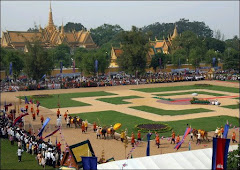

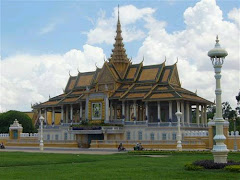

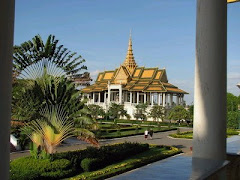
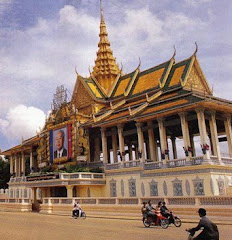
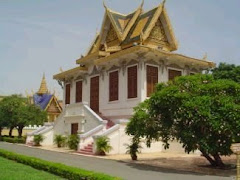
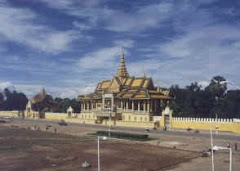
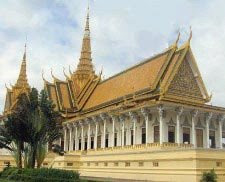

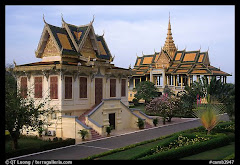





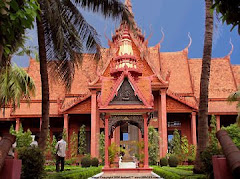
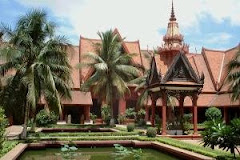




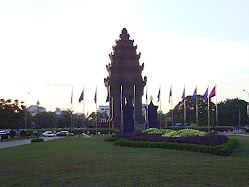



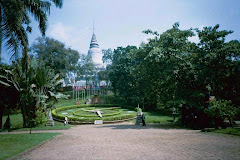

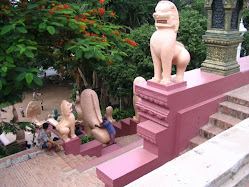
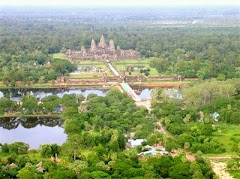
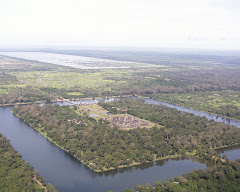

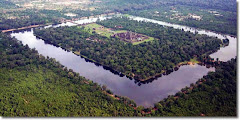
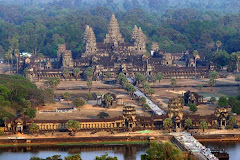
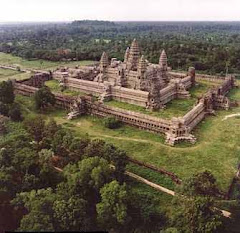
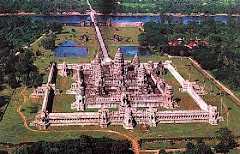
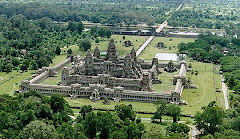
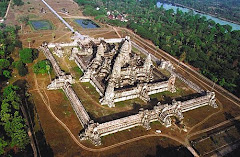

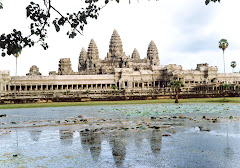

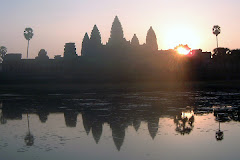
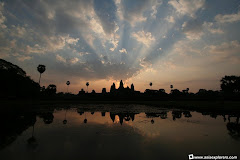
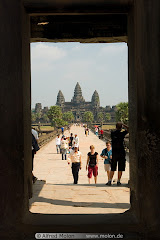
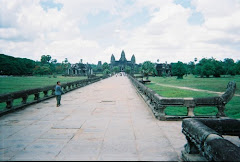
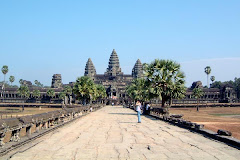
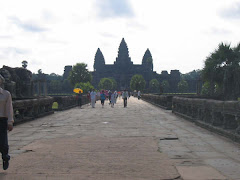
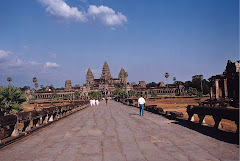
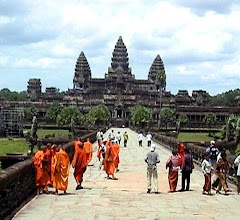
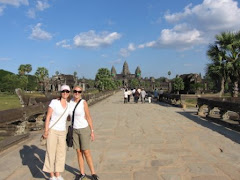
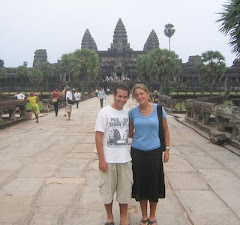
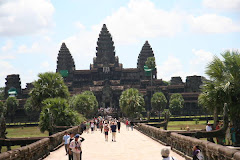
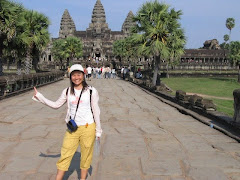
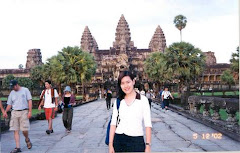

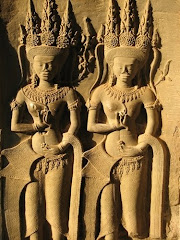

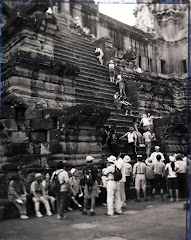

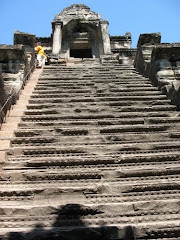

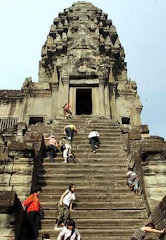
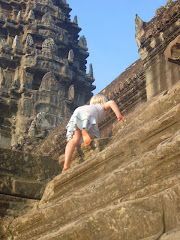
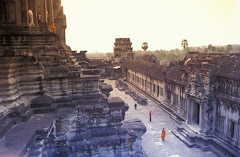
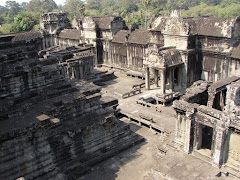
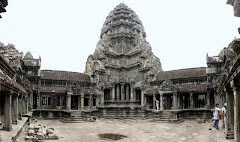
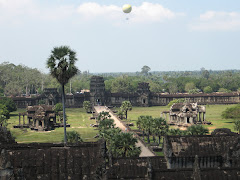


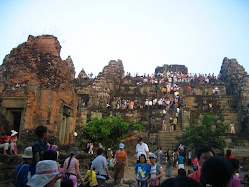

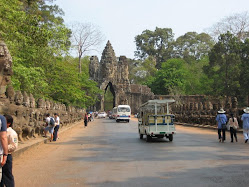

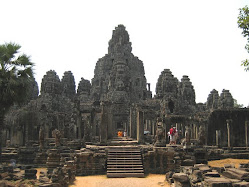
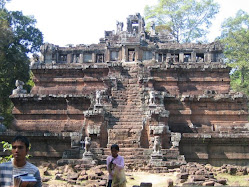.jpg)

